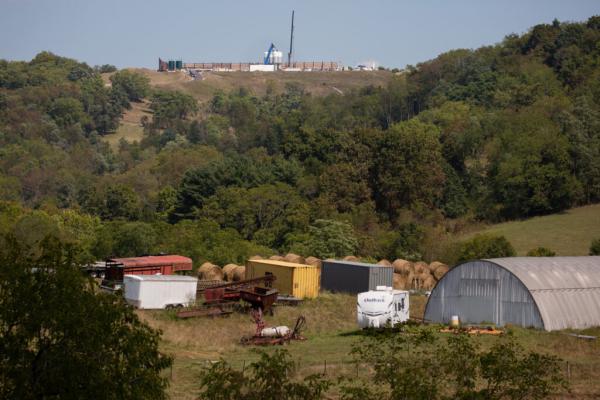Many factors influence the fate of pharmaceutical residues in the soil
Nov 6, 2025, 3:03 pm By NULLA comprehensive Hungarian study has revealed that the behavior of pharmaceutical residues in soil…What really happened on Easter Island? Ancient sediments rewrite the 'ecocide' story
Nov 6, 2025, 2:50 pm By NULLA new study led by researchers at the Lamont-Doherty Earth Observatory offers the clearest evidence…Asian summer monsoon's unusual role in 2021 Pacific Northwest heat wave revealed
Nov 6, 2025, 2:10 pm By NULLIn recent years, as extreme weather events have occurred with increasing frequency, scientists have…In the US, Western rivers may be allies in the fight against climate change
Nov 6, 2025, 2:00 pm By NULLFor decades, scientists have generally thought that rivers emit more carbon dioxide, a greenhouse…Space dust reveals Arctic ice conditions before satellite imaging
Nov 6, 2025, 2:00 pm By NULLArctic sea ice has declined by more than 42% since 1979, when regular satellite monitoring began. As…How the US cut climate-changing emissions while its economy more than doubled
Nov 6, 2025, 1:29 pm By NULLCountries around the world have been discussing the need to rein in climate change for three…Why Bill Gates' climate memo is being celebrated by skeptics while frustrating scientists
Nov 6, 2025, 1:26 pm By NULLShortly before COP30 talks begin in Brazil, tech billionaire and philanthropist Bill Gates has…World must face 'moral failure' of missing 1.5C: UN chief to COP30
Nov 6, 2025, 12:50 pm By NULLUN chief Antonio Guterres on Thursday said leaders must confront the "moral failure and deadly…UN says 2025 to be among top three warmest years on record
Nov 6, 2025, 12:44 pm By NULLAn alarming streak of exceptional temperatures has put 2025 on course to be among the hottest years…Arizona's Willcox basin is sinking fast due to groundwater extraction
Nov 6, 2025, 12:40 pm By NULLIn Arizona's Willcox Basin, just over an hour east of Tucson, fissures are tearing through the…Access to water has a long racial history in Durban: I followed the story in the city's archives
Nov 6, 2025, 12:26 pm By NULLThe water infrastructure politics of eThekwini, the municipality that includes the city of Durban,…Climate change will bring a surge in High Arctic groundwater discharge that will result in contaminant spread
Nov 6, 2025, 12:25 pm By NULLWarming temperatures and increased precipitation in the Canadian High Arctic are mobilizing new…Wildfire risk making timberland less valuable, long harvest rotations less feasible
Nov 6, 2025, 12:02 pm By NULLRising wildfire risk in the Pacific Northwest combined with notoriously volatile timber pricing may…How the plastics industry shifted responsibility for recycling onto you, the consumer
Nov 6, 2025, 10:50 am By NULLAustralia's recycling system has been lurching from one crisis to another for decades. Soft-plastic…What if the path to ending fossil fuels looked like the fight to end slavery?
Nov 6, 2025, 10:49 am By NULLWhen Britain abolished slavery in its empire in 1833, it paid the equivalent of hundreds of billions…Why even pro-climate action organizations may pull in different directions
Nov 6, 2025, 10:46 am By NULLThis year's UN climate summit (Cop30) in Belém, Brazil, begins with a familiar dilemma: how can we…Typhoon Kalmaegi hits Vietnam after killing 140 in Philippines
Nov 6, 2025, 10:10 am By NULLTyphoon Kalmaegi made landfall Thursday in Vietnam's already storm-battered central belt, where…China, world's top carbon pollutor, likely to overdeliver on climate goals. Will that be enough?
Nov 6, 2025, 9:55 am By NULLChina is likely to overdeliver on the modest goals the government has set to cut carbon pollution,…How Zone Zero, designed to protect California homes from wildfire, became plagued with controversy and delays
Nov 6, 2025, 7:20 am By NULLLate in October, California fire officials made a courtesy call to Los Angeles.Who is setting fire to the Amazon?
Nov 6, 2025, 4:30 am By NULL"Red John" is an old acquaintance of landowners and ranchers in the Brazilian Amazon.
Welcome to EcoTopical Your daily eco-friendly green news aggregator.
Leaf through planet Earths environmental headlines in one convenient place. Read, share and discover the latest on ecology, science and green living from the web's most popular sites.
Leaf through planet Earths environmental headlines in one convenient place. Read, share and discover the latest on ecology, science and green living from the web's most popular sites.





